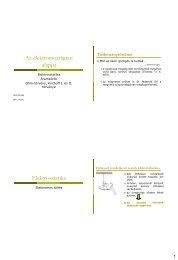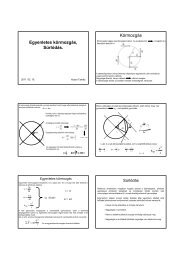Electromagnetic waves spectrum Electromagnetic waves, spectrum
Electromagnetic waves spectrum Electromagnetic waves, spectrum
Electromagnetic waves spectrum Electromagnetic waves, spectrum
You also want an ePaper? Increase the reach of your titles
YUMPU automatically turns print PDFs into web optimized ePapers that Google loves.
<strong>Electromagnetic</strong> <strong>waves</strong> <strong>waves</strong>, <strong>spectrum</strong><br />
Oct. 2012<br />
Biophysics 1 st semester<br />
József Orbán<br />
University of Pécs, Department of Biophysics
Light g – electromagnetic g radiation<br />
photon (quantum of radiation energy) : E = h f<br />
Dual nature of light:<br />
<strong>Electromagnetic</strong> wave Particle (photon)<br />
(propagation)<br />
Maxwell<br />
• Diffraction<br />
• Interference<br />
• Polarisation<br />
(reaction)<br />
Einstein<br />
A b s o r p t i o n<br />
R e f l e c t i o n<br />
• Photoelectric effect<br />
• Compton effect
Propagation of electromagnetic wave<br />
If = 600 nm then<br />
If = 600 nm, then<br />
f = 5·10 14 Hz<br />
x<br />
direction of<br />
propagation
E<br />
Propagation of electromagnetic wave<br />
electric field<br />
strength<br />
vector t<br />
x<br />
magnetic field<br />
strength vector<br />
B<br />
x<br />
transversal<br />
wave<br />
T: period time (in time)<br />
λ: wavelength (in space)<br />
c = f<br />
The electric- and the magnetic field strength vectors are<br />
perpendicular to each other and to the direction of<br />
propagation, ti as well!<br />
ll!<br />
x
Linearly y (plane) (p ) polarised p light g<br />
If the electric field’s field s strength vector<br />
oscillates in only one plane all along the<br />
propagation then the wave is called<br />
li linearly l or plane l polarised. l i d<br />
If it is true in each point of space in a light<br />
beam, then the beam is polarised, as well.<br />
http://esr.elte.hu/~noemi/labor/cd/demo0.html<br />
Animations show a<br />
vertically polarised<br />
electromagnetic wave (it’s<br />
electric field’s field s oscillation) oscillation).<br />
View from the perpendicular plane:
These animations show a horizontally polarised wave wave.<br />
Linearly (plane) polarised.<br />
Vi View ffrom the h perpendicular di l plane l <br />
http://esr.elte.hu/~noemi/labor/cd/demo0.html
Total spectra p of electromagnetic g radiations<br />
Energy, frequency (E=hf Wavelength (=1/f)<br />
Gamma<br />
X-ray (Röntgen)<br />
Visible range: light<br />
E = hf<br />
c = f
name of<br />
the range
Electronic energy gy levels of atoms<br />
Bohr- and quantummechanic atommodel<br />
Electrons have quantised (defined) energy→ energy levels!<br />
energy (level) energy difference<br />
Figures are only for demonstration!
Spectrum p<br />
Spectrum:<br />
• (light) ( g ) intensityy or analogous g quantity q y -<br />
plotted against<br />
• wavelength or frequency frequency.<br />
CLASSIFICATION OF SPECTRA<br />
Source:<br />
Types:<br />
• absorption ( atoms )<br />
• line ( atoms )<br />
• emission ( production p ) • band ( molecules )<br />
• continuous ( any material at<br />
high temperature: black body<br />
radiation )
Continuous Continuous, emission<br />
Line, emission<br />
Continuous, emission<br />
Line, emission<br />
Types of <strong>spectrum</strong><br />
I<br />
See: continuous emission radiation radiation, black body body, Planck Planck, Stefan Stefan-Boltzman<br />
Boltzman<br />
Source of images: http://csep10.phys.utk.edu/astr162/lect/light/absorption.html
absorption<br />
Continuous, emission<br />
Line, emission<br />
Line Line, absorption<br />
Types of <strong>spectrum</strong><br />
I<br />
See: continuous emission radiation radiation, black body body, Planck Planck, Stefan Stefan-Boltzman<br />
Boltzman<br />
Source of images: http://csep10.phys.utk.edu/astr162/lect/light/absorption.html
S p e c t r a<br />
Line type emission spectra of different atoms:
Band type yp (absorption) ( p ) <strong>spectrum</strong> p<br />
Absorpption<br />
2,5<br />
2,0<br />
1,5<br />
1,0<br />
0,5<br />
00 0,0<br />
of ACTIN molecule<br />
How can you explain the shape?<br />
The line spectra of atoms and<br />
band spectra of molecules are<br />
characteristic!<br />
(depends on their chemical<br />
constitution) tit ti )<br />
actin<br />
260 270 280 290 300 310 320<br />
Wavelength (nm)
Absorption p of proteins p - aminoacids<br />
There are 3 aminoacids that<br />
absorbs in UV UV.<br />
(Measuring the absorption spectra<br />
of protein solution solution, the<br />
concentration can be determined.)<br />
Exttinctionn<br />
coeefficientt<br />
wavelength g
our SUN
Mitosis of Rat kangoroo kidney epithelial cell<br />
DNS Mi Microtubuli t b li Mit Mitochondria h d i<br />
forrás: http://micro.magnet.fsu.edu/cells/fluorescencemitosis/index.html3













![Microsoft PowerPoint - Intermedier filamentumok [Kompatibilis m\363d]](https://img.yumpu.com/17119137/1/190x135/microsoft-powerpoint-intermedier-filamentumok-kompatibilis-m363d.jpg?quality=85)


